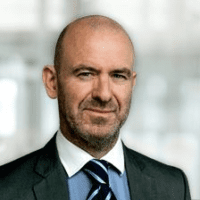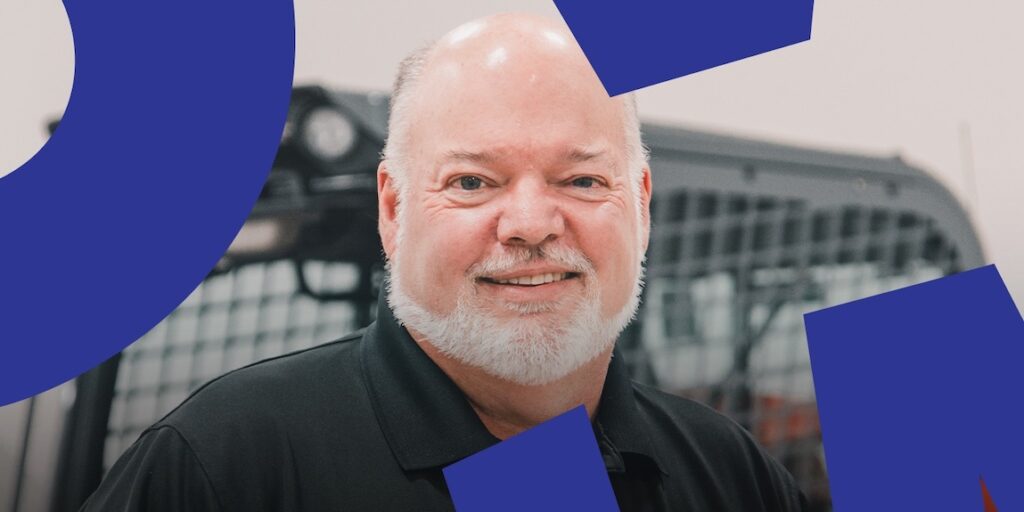

Pinning Takeuchi’s Clay Eubanks down for 45 minutes is no easy task. When The Interview catches up with him at the end of May, he’s in Nagano, headquarters to the Japanese OEM, some 250 kilometers north of Tokyo. The following week, he’s attending IRE in The Netherlands. The week after that, he’s in the US before returning to his permanent base back in Japan.
“We really do want to be good stewards of the resources that we have, to be a world leader and to be at the forefront of the technology that is coming.”
You get the drift. This is a busy man and he’s at the heart of everything Takeuchi does. And right now, what he’s most eager to expand upon is the OEM’s steady, but very clear shift towards electrification and everything that comes with it.
“At Takeuchi, we have a company philosophy that is all about clean energy and the environment,” says the director of global sales. “We really do want to be good stewards of the resources that we have, to be a world leader and to be at the forefront of the technology that is coming.”
That latter sentiment probably explains the long road that led to the TB20e’s introduction to the market in February this year. The lithium-ion powered compact excavator, it could be said, began life as a prototype that was first unveiled at Conexpo 2017.
“It was a bit before the market was ready for electrification and there were very good reasons for that,” says Eubanks. “There were valid question marks over the battery run time, the size of the battery and the lack of charging infrastructure. We were before our time.”
That doesn’t seem to be the case anymore. The TB20e enjoyed a limited roll out in North America and Japan in 2022 before being introduced to dealer networks in Europe this year. It has, says Eubanks, been given an “overwhelmingly positive” reception.
“Today’s battery will fit in the same size space as a diesel engine and has the same run time which has improved things dramatically,” says the near 40-year OEM veteran. “Add the reduction in noise pollution and increased cost of regulation on driven diesel engines on diesel particulate filters, silicon-controlled rectifiers, AdBlu and environmental control units to mention just a few, and the case starts to get compelling.
“But most importantly, there has also been a cultural and societal shift that helps to explain the overwhelmingly positive reception,” he says. “Seven years ago hardly anyone was talking about green energy, but as all stakeholders look to meet our sustainable development goals and ESG requirements, the picture has changed.
“That doesn’t mean we’ve overcome all the obstacles and there remains infrastructural issues as well as cost issues with the move towards electrification,” he adds. “But it’s happening.”
Indeed, says Eubanks, it creates quite a dilemma for OEMs as they look to manage their product portfolios going forward. He anticipates Takeuchi will have a mixed product offering for some years yet, but that everyone is already carefully watching for the moment when the trend becomes irreversible.
“The rate at which we are moving towards the tipping point you could argue is very slow, but there is a tipping point on electrification,” says the Atlanta, Georgia native. “When it tips, it will be rapid.”
It’s about balancing what Takeuchi’s customers in the rental and contractor segments want while also recognizing the more subtle move in society and among those very same customers towards a better construction landscape that they want to be part of that is integral to better solutions. That’s a balance Takeuchi has so far managed adroitly with a 19.7% increase in net profits for the last fiscal year to USD 119.5 million and a projected net profit increase for the year ahead of 7.6%.
But making profits in an uncertain market is only one of a number of challenges that OEMs are having to contend with. Takeuchi, he says, is becoming less like a manufacturer and more like a software company with each passing year. “The days of designing product on the back of a napkin are over,” he says tellingly.
But the impression he gives is that this is necessary change and what lies ahead is a potentially much better future for the sector and construction as a whole. Take the thorny issue of greenwashing as one example.
“Through telematics, we will be able to get a much clearer picture on our scope 3 emissions and that will over time allow us to do much better reporting through the supply chain and that’s key.”
“As part of our SDGs, we’ve become really good at reporting our scope 1&2 emissions, but accurately calculating scope 3 when we effectively pass on the product down the logistical chain is much more difficult,” he says. “Inevitably there is some skepticism among investors and society when it comes to reporting those numbers once the product has ‘gone’, but investors are getting much more clever about greenwashing and watching very closely.
“And through telematics, we will be able to get a much clearer picture on our scope 3 emissions and that will over time allow us to do much better reporting through the supply chain and that’s key.”
Indeed, Eubanks sees a key role ahead for telemetry via the incredible level of data points churned out daily, and anticipates the day when proper Emissions Reporting metrics can be established through the industry. While he says collaboration among Takeuchi’s peers could be better, an evolving sense of responsibility that could land upon some kind of standardization totem is evident.
“There’s a governmental drive for this too,” he says, warming to the theme. “The planned legislation in California on emissions will drive the costs of a diesel machine up toward the same level as electrification models. That’s why when we cross the tipping point, the move will be so quick.”
That bottom-line recognition running parallel to a desire not to fall foul of the criteria for government-mandated projects is the next big development, he says. While he laments a lack of activism in Asia where it “is several years” behind the curve, he expects regulatory pressure like California’s pioneering efforts on emissions reporting and the EU’s increasingly stringent environmental regulation to eventually seep into the debate and foster action.
He cites as an example the dramatic changes he already sees among graduates in Japan and what they expect from a company like Takeuchi.

“We just went through a round of graduate recruitment and every single one of these Japanese students wanted to know what our plans were on sustainability. It was very, very important to them,” says Eubanks. “They were effectively interviewing us.”
Eubanks highlighted how those same graduates were similarly vexed on the subject of Japan’s work culture and gender differentials. “It shows how globalization changes things,” he says. “That simply would not have happened five years ago and they are clearly no longer willing to accept the culture that existed before. We can only see this as a good development.”
“We just went through a round of graduate recruitment and every single one of these Japanese students wanted to know what our plans were on sustainability. It was very, very important to them. They were effectively interviewing us.”
Indeed, for someone who first entered the industry in 1984, the rate of change in the last few years has astonished the Takeuchi sales chief and the degree of connectivity now evident across construction takes his breath away.
“The technology is already here for the automated operation of machines and I could operate a machine thousands of miles away through a connected device,” he says. “That technology will continue to develop and don’t be surprised if a new power source of some type emerges in the next 10 years that might make us look back at the current electrification technology and think how basic that was.”
It’s a tantalizing glimpse into the future. And one that should help construction in its perennial battle against downtime, its drive towards sustainability and its efforts to become an ever more attractive employer.
“Labor shortages are going to be a real challenge and we’ll probably be increasingly tech-reliant,” Eubanks adds.“ Inclusivity is the issue and it’s just as relevant here in Japan as it is in North America and Europe.”
With that, Eubanks takes his leave. But if he’s reflective of a different way of thinking within construction and among OEMs, you can’t help thinking the industry is in good hands. We can only hope so.
Are you inspired by this story? To receive three insightful reads on data, strategy and tech from people across the construction industry in your inbox once a month, sign up to the Eliminate Downtime newsletter.
Never miss an insight. We’ll email you when new articles are published on this topic.
